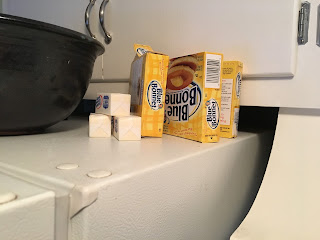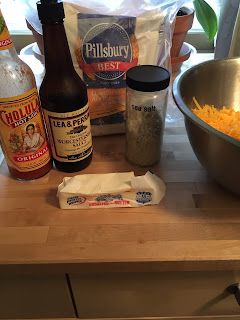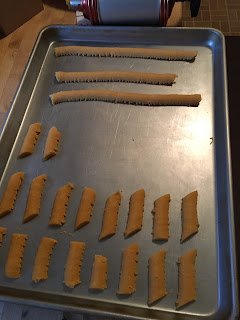Let's start with some pertinent info right out of the gate: I know very little about wine. I know that I like some of it and that I don't like some of it. That's pretty much it.
I know a little bit more about Beaujolais Nouveau: It's French. It comes out in the fall of every year. It doesn't really age well, so you need to drink it fairly soon. It's red, and kind of fruity or berry-y. And - I just learned this this week - although liquor stores may get it in early, it can't go out on the shelf until a mandated specific day (much like the latest
Harry Potter book, or a Black Friday television).
Here is a bottle of this year's vintage:
 |
| You can tell it's from this year, because it's November 18th, and there's just a little rain outside, no snow. (You can also tell because it says "2016" right on the label.) |
Oh, and one other thing: people tend to have parties to celebrate the release of the new vintage. And, in fact, Christopher and I were invited to one for tonight. We were asked to cheese or crackers along with our bottle, and so - as we are wont to do - we decided I should whip up some "cheese straws" for the occasion.
Cheese straws are... well... they're like a homemade cross between crunchy Cheetohs and Cheese-Its. And, really, they're pretty easy to make, especially if you can reach over and pull
The Joy of Cooking off your shelf (and you happen to have a pound or two of Cheddar cheese in the fridge left over from your last Costco run).
 |
| I love this cookbook! It was a Christmas gift from my parents in 1988 - when I was living off campus during my senior year of college. It's beginning to fall apart, but I will not replace it, because the newer editions changed the way recipes are presented. |
So, here's the basic recipe for what we're doing (which I doubled):
 |
| "4 dozen" is a bit optimistic, I think. |
The first step - which I had completely forgotten about until this morning - is to soften your butter. As you know if you read
last week's post, I tend to be pretty old school about some things in my kitchen. So, for about an hour and a half this morning, this was the scene on the top of our fridge:
 |
| Six tablespoons of butter, just hanging out and softening... |
While the butter was limbering up, I headed for the grater and started in on the rest of the ingredients. I mainly used the small grating side, and combined half medium Cheddar with half "extra sharp" aged Cheddar. Since the recipe is a little loose on how much to use, I shot right down the middle and ended up with about twelve ounces of cheese.
With the butter softened (and yesterday's dishes washed... and insulating film put up on the bedroom windows... and the dog walked - it's amazing what you can do while waiting for butter to soften), I started working everything together. Yes, with my hands.
I worked the butter and cheese together, first, then dumped everything else on top.
 |
| I know that it kind of looks like I murdered something in there, but it's the Cholula hot sauce and Worcestershire sauce on top of the flour. |
|
|
I don't have a photo of what it looked like when it was all mixed. Imagine a large ball of pale orange Play-Doh, though, and you'd be pretty much right.
It's kind of strange, though - I put in a lot more than a "dash" of hot sauce, and followed the rest of the instructions, but the "dough" still mainly tasted of cheese. So... well... I'll tell you about that later.
 |
| Not quite as old as the cookbook, I've had this press since grad school - so maybe 1991? |
Christopher and I debated which size tube to use, and although the small circle would probably have been the most appropriate (and probably would have resulted in the "4 dozen" per batch, honestly), we opted for the semi-circular tip.
I'm not going to lie - I'm glad we chose the mid-sized tip, because the cheese dough was hard enough to get through that one. I can only imagine what it would have been like to get it through the smaller one.
I started out by piping the dough out in long strips on my ungreased cookie sheets (I contemplated using parchment paper, which I might do in future), then cut each to approximately two inches in length (leaning very heavily on the "approximately" factor).
They headed into a 475-degree oven, and - after making the entire house smell like cheese - came out about twelve minutes later looking (mostly) like this:
Remember how I said the dough was a little bland? Well, we remedied that by sprinkling them with some flavored salt right as they came out of the oven. There was a quick debate between salt or cayenne pepper, but I found a "five pepper salt" (really, it's mainly salt, but has cayenne, chipotle, red pepper, and some other things in it) in the cupboard, and so I used that. It added just enough extra zing to really make these work.
 |
| I feel this should have one of those box cover notices that says "enlarged to show texture" - but I'm guessing you all figured that out, already. |
Christopher (who is working from home today - I'm not running stuff back and forth to him at his office) tried one and had the same reaction I did: they're nicely crisp on the outside, but slightly soft/chewy on the interior.
Now, assuming that we're not piled under a foot of snow in the next 6 hours, we'll be able to celebrate the Beaujolais Nouveau with cheese straw style.
REMINDER: I'm on the lookout for random things to bake/cook. If you've got a recipe that you're afraid of because you're not sure how it will turn out, or if you have a recipe that turned out odd and you want someone else to try it, let me know and I'll see what I can do!

















































